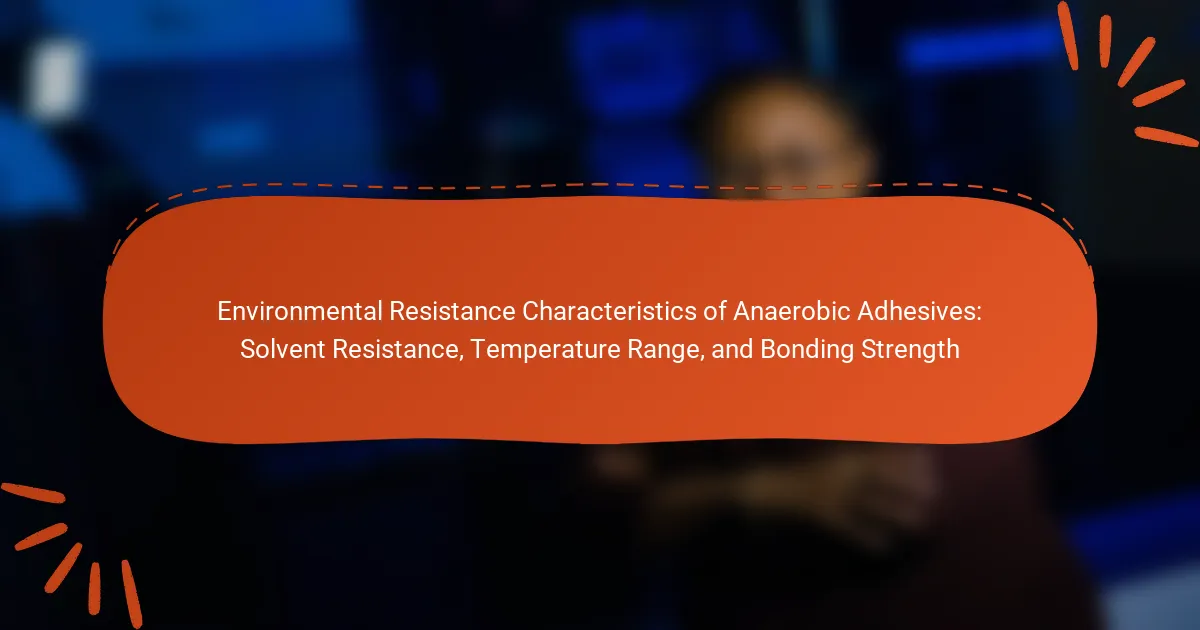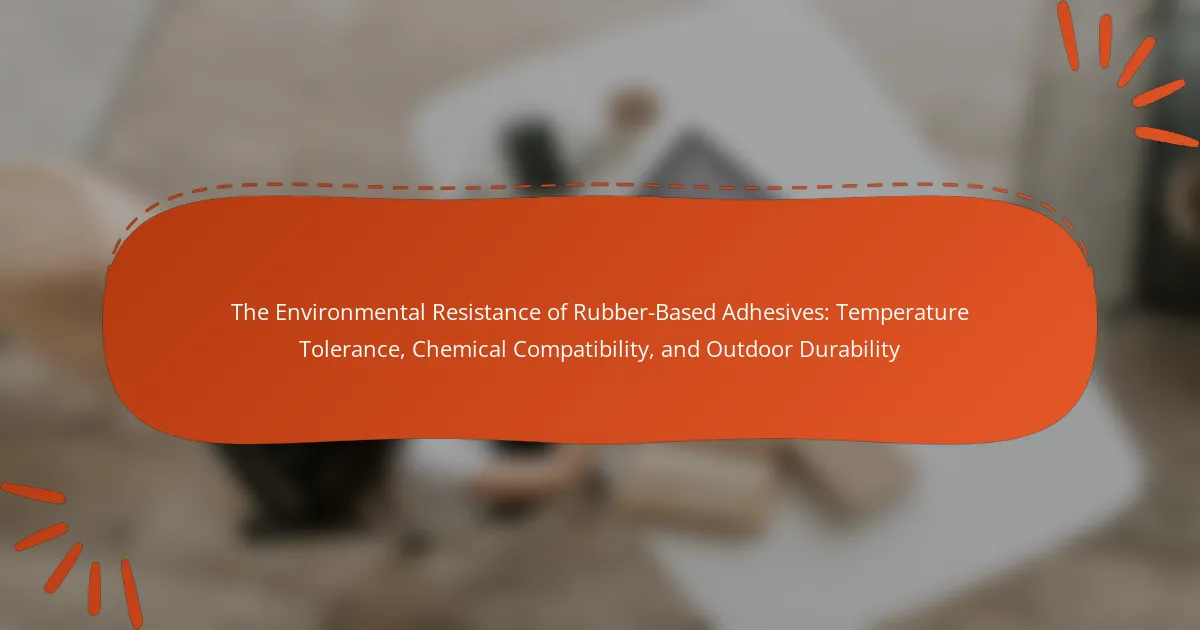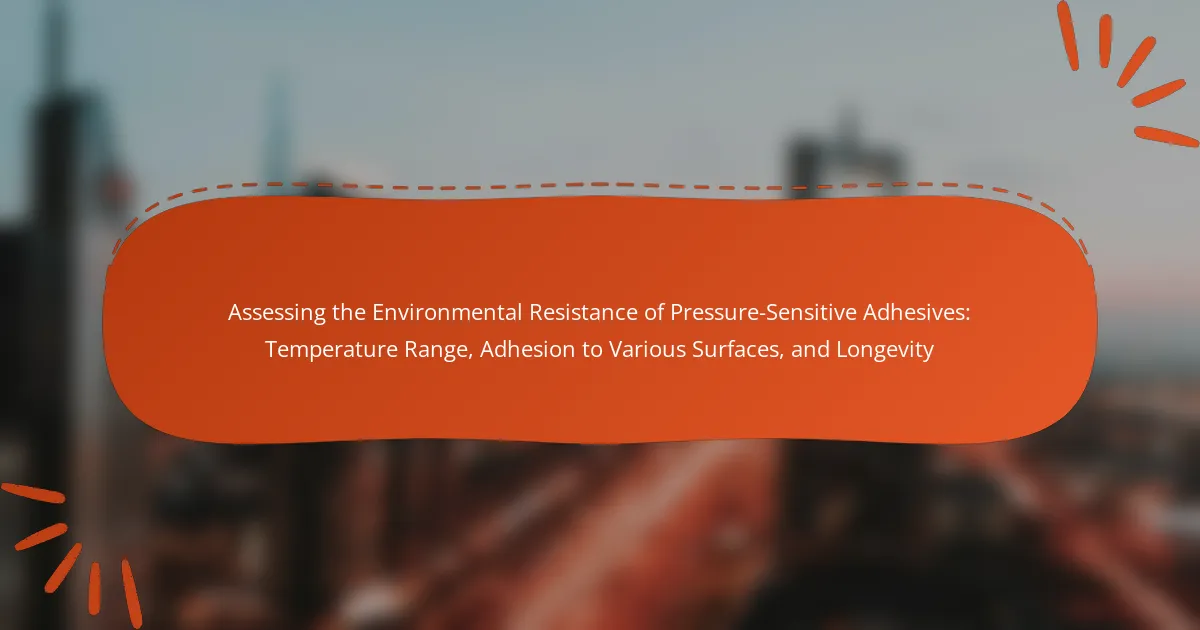Anaerobic adhesives are specialized bonding agents that cure in the absence of air, providing exceptional environmental resistance. They exhibit strong resistance to solvents, oils, fuels, moisture, and vibration, making them suitable for demanding industrial applications such as automotive and aerospace. With a temperature tolerance ranging from -55°C to 150°C, and in some cases up to 200°C, these adhesives maintain their bonding strength under extreme conditions. Their performance is further enhanced by specific formulations designed to resist degradation from various solvents, ensuring durability and reliability in high-exposure environments. The bonding strength of anaerobic adhesives is rigorously tested using standardized methods, ensuring consistent and reliable measurements for various applications.
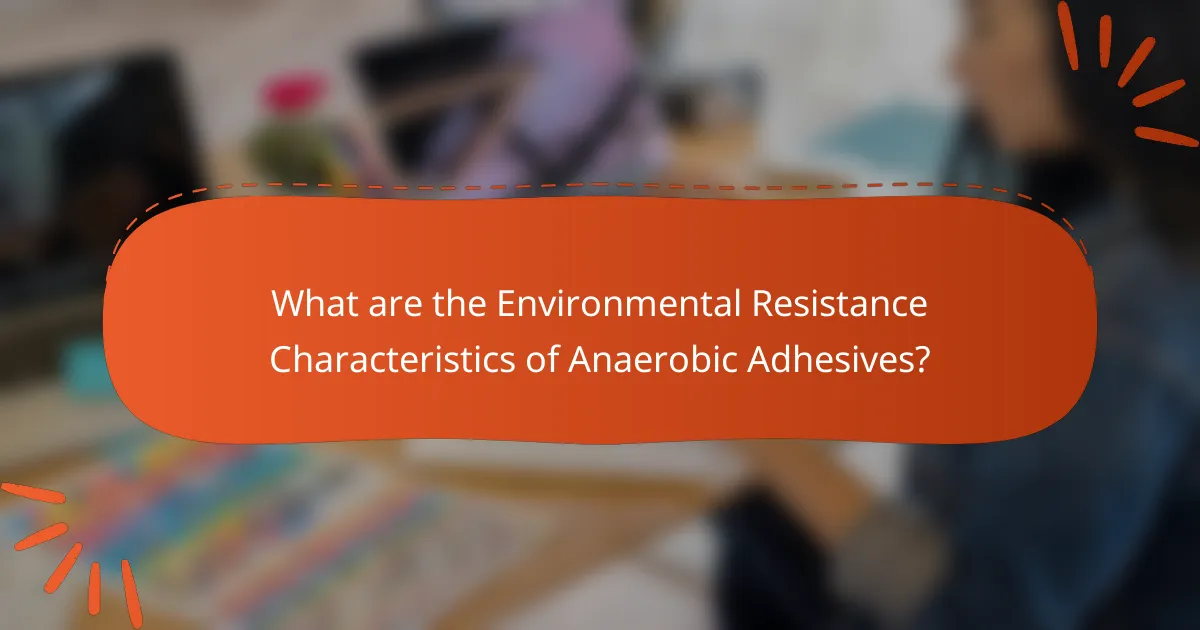
What are the Environmental Resistance Characteristics of Anaerobic Adhesives?
Anaerobic adhesives exhibit strong environmental resistance characteristics. They are resistant to solvents, oils, and fuels. This makes them suitable for various industrial applications. Anaerobic adhesives can withstand a wide temperature range, typically from -55°C to 150°C. Their bonding strength remains intact under these conditions. These adhesives cure in the absence of air, enhancing their durability. They also provide resistance to moisture and vibration. This resilience ensures long-lasting bonds in challenging environments.
How do solvent resistance, temperature range, and bonding strength affect anaerobic adhesives?
Solvent resistance, temperature range, and bonding strength significantly affect anaerobic adhesives. Solvent resistance determines an adhesive’s ability to maintain bond integrity in the presence of chemicals. High solvent resistance prevents degradation and ensures durability in harsh environments. Temperature range defines the operational limits within which the adhesive remains effective. Anaerobic adhesives typically perform well in a specific temperature range, often between -55°C to 150°C. Outside this range, adhesive performance can decline, leading to bond failure. Bonding strength refers to the adhesive’s capacity to hold materials together under stress. Strong bonding strength is crucial for applications requiring reliable, long-lasting adhesion. Research shows that anaerobic adhesives with high bonding strength can withstand significant loads without failure.
What is solvent resistance in the context of anaerobic adhesives?
Solvent resistance in the context of anaerobic adhesives refers to the adhesive’s ability to withstand exposure to various solvents without losing its bonding strength. This characteristic is crucial for applications where adhesives may come into contact with chemicals or solvents. Anaerobic adhesives are designed to cure in the absence of air, which enhances their performance in challenging environments. The solvent resistance of these adhesives can vary based on their formulation and the specific solvents involved. Testing for solvent resistance typically involves exposing the adhesive to solvents for a defined period and measuring any changes in bond strength. Strong solvent resistance indicates that the adhesive can maintain its integrity and effectiveness even in harsh chemical conditions.
How does temperature range influence the performance of anaerobic adhesives?
Temperature range significantly influences the performance of anaerobic adhesives. Anaerobic adhesives cure in the absence of air, and their curing speed and final bond strength can vary with temperature. Optimal curing typically occurs between 20°C to 30°C. At lower temperatures, curing slows down, potentially leading to weak bonds. Conversely, high temperatures can accelerate curing but may also lead to brittleness. Studies show that performance diminishes outside the recommended temperature range. For instance, curing at temperatures below 10°C can result in incomplete polymerization. Maintaining the adhesive within the specified temperature range ensures maximum bonding strength and durability.
What factors contribute to the bonding strength of anaerobic adhesives?
The bonding strength of anaerobic adhesives is influenced by several key factors. These factors include the chemical composition of the adhesive, surface preparation, and the presence of contaminants. The chemical composition determines the adhesive’s curing mechanism and its ability to bond with substrates. Proper surface preparation enhances adhesion by increasing surface area and removing contaminants. Contaminants such as oil or dust can significantly weaken the bond. Additionally, environmental conditions like temperature and humidity can affect curing time and bond strength. Research indicates that optimal curing conditions lead to stronger bonds. For instance, a study published in the Journal of Adhesion Science and Technology highlights the importance of surface cleanliness for achieving maximum bonding strength.
Why are environmental resistance characteristics important for anaerobic adhesives?
Environmental resistance characteristics are crucial for anaerobic adhesives because they determine the adhesive’s performance in various conditions. These characteristics ensure that the adhesive maintains its bond strength when exposed to solvents, humidity, and temperature fluctuations. For instance, solvent resistance prevents the adhesive from degrading in chemical environments. Temperature range characteristics allow the adhesive to function effectively in both high and low-temperature applications. Research has shown that anaerobic adhesives can lose effectiveness if environmental resistance is inadequate, leading to bond failure. Therefore, understanding these characteristics is essential for selecting the right adhesive for specific applications.
What applications rely on the environmental resistance of anaerobic adhesives?
Anaerobic adhesives are used in various applications due to their environmental resistance. These adhesives are commonly employed in automotive assembly for securing components against vibration and temperature fluctuations. They are also utilized in the aerospace industry for bonding parts exposed to extreme conditions. In plumbing, anaerobic adhesives provide leak-proof seals in pipes and fittings. Additionally, they are used in manufacturing for securing threaded fasteners against loosening. Their ability to withstand solvents and temperature extremes ensures reliability in these critical applications.
How do environmental factors impact the longevity of anaerobic adhesive bonds?
Environmental factors significantly impact the longevity of anaerobic adhesive bonds. Temperature variations can cause expansion and contraction in bonded materials. High temperatures may accelerate the curing process but can also weaken the bond over time. Conversely, low temperatures can slow curing, leading to incomplete bonding. Humidity levels affect moisture ingress, which can degrade the adhesive. Exposure to solvents can also break down the adhesive’s chemical structure. Each of these factors can lead to reduced bond strength and premature failure. Studies indicate that optimal bonding occurs within specific temperature and humidity ranges, emphasizing the importance of environmental conditions.
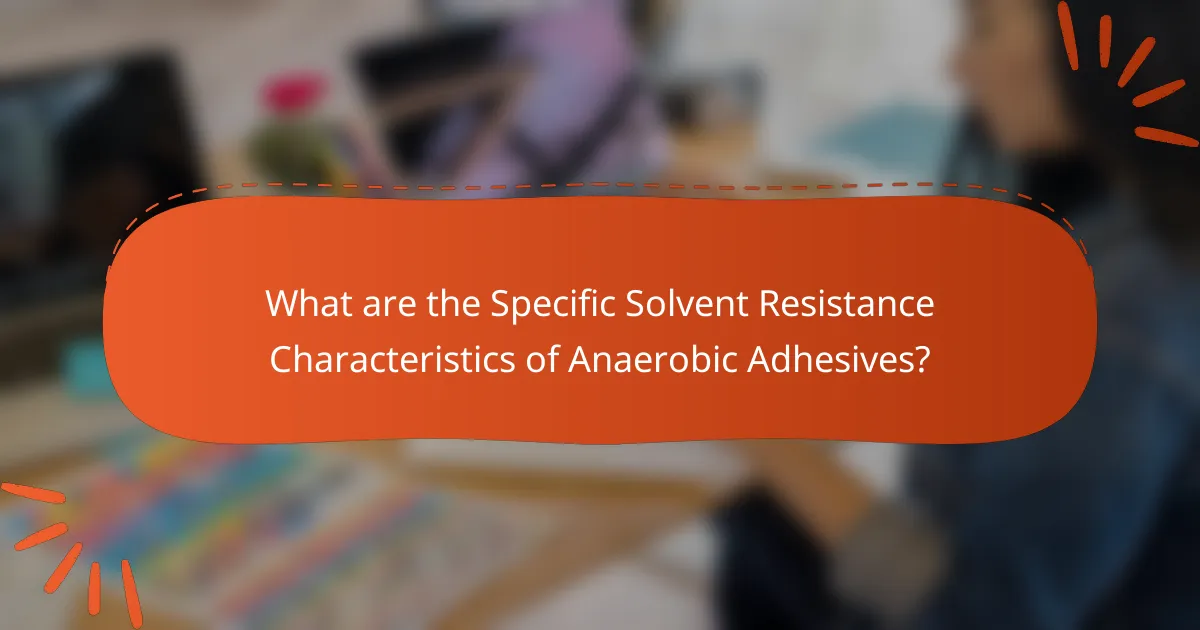
What are the Specific Solvent Resistance Characteristics of Anaerobic Adhesives?
Anaerobic adhesives exhibit specific solvent resistance characteristics that enhance their performance in various environments. They are designed to resist degradation when exposed to solvents such as alcohols, hydrocarbons, and chlorinated solvents. This resistance is attributed to their chemical structure, which forms strong bonds that remain intact even in challenging conditions.
Research indicates that anaerobic adhesives maintain their integrity in environments with high solvent exposure. For instance, studies have shown that certain formulations can withstand immersion in solvents for extended periods without significant loss of bond strength. This durability makes them suitable for applications in automotive, aerospace, and industrial settings where solvent exposure is common.
Additionally, the specific solvent resistance of anaerobic adhesives can vary based on their formulation. Some products are specially engineered to offer enhanced resistance to particular solvents, providing tailored solutions for specific applications.
How do different solvents interact with anaerobic adhesives?
Different solvents can significantly affect the performance of anaerobic adhesives. Anaerobic adhesives cure in the absence of air and rely on specific chemical interactions. Polar solvents, such as water and alcohols, can disrupt the curing process by interfering with the adhesive’s polymerization. Non-polar solvents, like hydrocarbons, have less impact on the curing but may still weaken the bond over time.
Research indicates that solvents can cause swelling or softening in the adhesive matrix. This phenomenon can lead to reduced mechanical strength and adhesion properties. For example, acetone can rapidly degrade certain anaerobic formulations. Testing shows that prolonged exposure to solvents can decrease bond strength by up to 50%.
Understanding these interactions is crucial for selecting the right adhesive for specific environments. Proper solvent selection ensures optimal performance and longevity of the adhesive bond.
What types of solvents are most commonly tested for resistance?
The most commonly tested solvents for resistance include acetone, ethanol, isopropanol, and toluene. These solvents are frequently used in laboratory settings to assess the durability of materials. Acetone is known for its strong solvent properties and ability to dissolve various substances. Ethanol is often tested due to its widespread use in cleaning and disinfecting applications. Isopropanol is significant for its effectiveness in removing oils and residues. Toluene is included for its ability to dissolve polymers and resins. Testing these solvents helps determine the environmental resistance of anaerobic adhesives.
How does solvent exposure affect the adhesive’s performance over time?
Solvent exposure negatively affects the performance of adhesives over time. Prolonged contact with solvents can lead to the degradation of adhesive properties. This degradation may result in reduced bond strength and increased susceptibility to failure. Adhesives can lose their flexibility and become brittle when exposed to certain solvents. Studies show that specific solvents can accelerate the hydrolysis of adhesive polymers. This process compromises the adhesive’s structural integrity. Additionally, solvent exposure can lead to swelling or softening of the adhesive matrix. Overall, the longevity and effectiveness of adhesives are significantly impacted by solvent exposure.
What are the implications of solvent resistance for various industries?
Solvent resistance in anaerobic adhesives has significant implications for various industries. It enhances the durability and longevity of bonded joints in environments exposed to solvents. Industries such as automotive benefit from solvent resistance, as it ensures the integrity of components in fuel systems. The aerospace sector relies on solvent-resistant adhesives for reliable bonding in aircraft manufacturing. In electronics, solvent resistance protects connections from chemical exposure, improving device reliability. Additionally, the construction industry utilizes solvent-resistant adhesives for structural applications, ensuring safety and performance. Overall, solvent resistance is crucial for maintaining the performance and safety of products across multiple sectors.
Which industries benefit from high solvent resistance in anaerobic adhesives?
The automotive, aerospace, and manufacturing industries benefit from high solvent resistance in anaerobic adhesives. These industries require adhesives that can withstand harsh environments. Automotive applications often involve exposure to fuels and oils. Aerospace components face extreme temperatures and chemical exposure. Manufacturing processes may include the use of solvents and cleaning agents. High solvent resistance ensures durability and reliability in these applications. This characteristic helps maintain the integrity of bonds under challenging conditions.
How can businesses select anaerobic adhesives based on solvent resistance?
Businesses can select anaerobic adhesives based on solvent resistance by evaluating the specific solvents they will encounter. They should review the product data sheets provided by manufacturers. These sheets detail the solvent resistance ratings for various adhesive formulations. Additionally, businesses should consider the type of bonding application and environmental conditions. Testing adhesives in real-world scenarios can also provide insights into their performance. Manufacturers often conduct standardized tests to assess solvent resistance. These tests can help predict how well the adhesive will perform under exposure. By combining manufacturer data with practical testing, businesses can make informed selections.

What is the Temperature Range Tolerance of Anaerobic Adhesives?
Anaerobic adhesives typically have a temperature range tolerance of -55°C to 150°C. This range allows them to perform effectively in various environmental conditions. Some specialized formulations can withstand temperatures up to 200°C. The ability to maintain bond strength across this range is crucial for applications in automotive and industrial settings. Testing has shown that these adhesives retain their properties even under extreme temperatures. Therefore, their temperature range tolerance is a key characteristic that defines their usability in different environments.
How does temperature affect the curing process of anaerobic adhesives?
Temperature significantly affects the curing process of anaerobic adhesives. Higher temperatures generally accelerate the curing rate. This occurs because increased thermal energy enhances the reaction kinetics of the adhesive components. Conversely, lower temperatures can slow down or even inhibit the curing process. At temperatures below the recommended range, the adhesive may remain uncured for extended periods. For instance, many anaerobic adhesives cure optimally between 20°C to 30°C. Outside this range, particularly below 10°C, the curing time can extend dramatically. This relationship is crucial for ensuring proper bonding strength and performance of the adhesive in applications.
What are the optimal temperature ranges for application and curing?
The optimal temperature range for application of anaerobic adhesives is between 15°C to 30°C (59°F to 86°F). Curing typically occurs best within a similar range, with ideal conditions being 20°C to 25°C (68°F to 77°F). These temperatures facilitate proper adhesion and bonding strength. Research indicates that temperatures below 15°C can slow the curing process significantly. Conversely, temperatures above 30°C may lead to premature curing or reduced bond strength. Maintaining these temperature ranges ensures maximum effectiveness and reliability of anaerobic adhesives.
What happens to anaerobic adhesives when exposed to extreme temperatures?
Anaerobic adhesives can degrade when exposed to extreme temperatures. High temperatures may cause these adhesives to lose their bonding strength. They can become less viscous, leading to reduced effectiveness. Conversely, low temperatures can result in increased viscosity. This change can hinder the adhesive’s ability to flow and bond properly. Prolonged exposure to extreme temperatures may also lead to chemical breakdown. This breakdown can compromise the adhesive’s structural integrity. Therefore, maintaining optimal temperature conditions is crucial for performance.
What are the best practices for using anaerobic adhesives in varying temperatures?
The best practices for using anaerobic adhesives in varying temperatures include selecting the right adhesive formulation for the temperature range. Anaerobic adhesives generally perform best at temperatures between 20°C and 30°C. For lower temperatures, choose adhesives specifically designed for cold environments. These formulations often contain additives that enhance curing at lower temperatures.
For higher temperatures, select adhesives that can withstand heat without losing strength. Many anaerobic adhesives have a maximum service temperature, which should not be exceeded. Surface preparation is crucial; clean and dry surfaces improve adhesion and performance.
Applying the adhesive in thin layers ensures even curing and optimal strength. In extreme temperatures, allow extra time for curing as the reaction rate may slow down. Monitoring the ambient temperature during application is essential for achieving desired bond strength.
How can users ensure effective bonding in high or low-temperature environments?
Users can ensure effective bonding in high or low-temperature environments by selecting appropriate anaerobic adhesives. These adhesives are specifically formulated to perform well across a range of temperatures. For high-temperature applications, users should choose adhesives with heat resistance ratings above the expected service temperature. For low-temperature applications, selecting adhesives that remain flexible and maintain bond strength at lower temperatures is crucial.
Testing the adhesive in the specific environmental conditions before full application can help confirm its effectiveness. Additionally, surface preparation is vital. Clean and dry surfaces enhance adhesion, regardless of temperature. Following the manufacturer’s instructions on curing times and conditions also ensures optimal bonding performance.

How is Bonding Strength Measured in Anaerobic Adhesives?
Bonding strength in anaerobic adhesives is measured using tensile strength tests. These tests evaluate the adhesive’s ability to withstand pulling forces. The process typically involves bonding two substrates and applying a tensile load until failure occurs. The maximum load at which the bond fails is recorded. This value is then divided by the bonded area to calculate the bonding strength in units like psi or MPa. Standard testing methods include ASTM D1002 and ISO 4587. These methods ensure consistent and reliable measurements across different adhesive formulations.
What tests are commonly used to evaluate bonding strength?
Common tests used to evaluate bonding strength include tensile tests, shear tests, and peel tests. Tensile tests measure the force required to pull a bonded joint apart. Shear tests assess the strength of the bond in a direction parallel to the adhesive layer. Peel tests evaluate the resistance of a bond to forces that attempt to separate it at the interface. Each test provides valuable data on the performance and durability of adhesive bonds under various conditions. These methods are widely recognized in industry standards such as ASTM D1002 for shear strength and ASTM D1876 for peel strength.
How do different substrates affect the bonding strength of anaerobic adhesives?
Different substrates significantly influence the bonding strength of anaerobic adhesives. The chemical composition and surface characteristics of substrates affect adhesive performance. For example, metals like steel provide high bonding strength due to their smooth surfaces and chemical reactivity. In contrast, porous materials such as wood may absorb adhesive, reducing bond integrity.
Surface preparation also plays a critical role. Clean, roughened surfaces enhance adhesion by increasing contact area. Conversely, contaminants like oils or dust can weaken the bond. Research shows that bonding strength can vary by over 50% depending on substrate type and preparation method.
Studies indicate that specific surface treatments, such as priming, can further improve adhesion on challenging substrates. This highlights the importance of substrate selection and preparation in achieving optimal bonding strength with anaerobic adhesives.
What role does surface preparation play in achieving optimal bonding strength?
Surface preparation is critical for achieving optimal bonding strength. Proper surface preparation removes contaminants and irregularities. This ensures a clean, smooth interface for adhesive application. A well-prepared surface enhances adhesive [censured] and contact. Studies show that untreated surfaces can lead to weak bonds. For example, a study published in the Journal of Adhesion Science and Technology found that surface roughness directly affects bond strength. Enhanced surface energy from preparation increases adhesive performance. Therefore, effective surface preparation is essential for maximizing bonding potential.
What are the practical tips for maximizing bonding strength in anaerobic adhesives?
To maximize bonding strength in anaerobic adhesives, surface preparation is crucial. Clean the surfaces thoroughly to remove contaminants. Use solvents or abrasive methods for optimal adhesion. Proper alignment of the parts before curing enhances bond integrity. Apply the adhesive evenly to ensure full coverage. Follow the manufacturer’s recommended curing time and temperature for best results. Avoid excessive movement of the bonded parts during curing. Store anaerobic adhesives properly to maintain their effectiveness. These practices are supported by industry standards that emphasize surface cleanliness and correct application techniques.
How can users troubleshoot common bonding strength issues?
Users can troubleshoot common bonding strength issues by assessing surface preparation. Ensure surfaces are clean and free from contaminants. Dust, oil, or moisture can weaken bonds. Users should also verify the correct adhesive type for the materials. Different adhesives have specific bonding strengths and compatibility. Another step is to check the application method. Proper mixing and application techniques are crucial for optimal bonding. Users should also consider curing conditions. Temperature and humidity can affect adhesive performance. Lastly, review the adhesive’s shelf life. Expired adhesives may not perform as expected.
The main entity of this article is anaerobic adhesives, which are characterized by their strong environmental resistance, specifically regarding solvent resistance, temperature range, and bonding strength. The article provides an in-depth analysis of how these adhesives perform in various conditions, including their ability to withstand solvents, maintain bond integrity across a temperature range of -55°C to 150°C, and the factors influencing their bonding strength. Key applications in industries such as automotive, aerospace, and manufacturing are highlighted, emphasizing the importance of environmental resistance for ensuring durability and reliability. Additionally, the article discusses best practices for surface preparation, testing methods for bonding strength, and troubleshooting common issues to maximize adhesive performance.
